Star Wars Battlefront 2 review in progress
A fun campaign, over-complicated progression, and a strange multiplayer flagship.
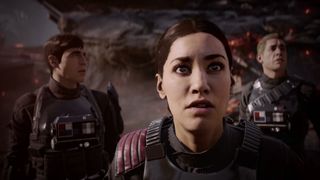
Star Wars Battlefront 2 is a weird multiplayer game. In its flagship Galactic Assault mode, 20 attackers fight 20 defenders in bizarro versions of Star Wars battles. Endor, Jakku, Kashyyyk, all the hits. Like in the Battlefield series, players can spawn in powerful land and air vehicles, but also as Yoda, if they earn enough points as a basic trooper. Or Kylo Ren. Or a wookiee, a flametrooper, a battle droid, a rocket jumper. And rather than capturing bases spread across a wide landscape, we're sent sprinting at each other down streets and through corridors, contesting points with grenade spam and insta-kill lightsabers and special abilities that range from deployable turrets to shields and buffs. Imagine a 40-player Overwatch match where everyone is a different character, and some are always using their ultimates.
The maps typically start somewhat spacious and then funnel players into smaller objectives. At the start, I enjoy plopping down in the back to snipe (I know, I'm that guy), as it lets me focus on accuracy rather than dance-dodging rockets and super-powered blasters and aerial bombardments. In close quarters, I like awkwardly taking flight as a jet trooper or rocket droid, both of whom can boost vertically with little control. It's a one-button escape that gives me time to reset, relief from the chaos.
So far, it's rare that I earn enough points to spawn as a Hero character—I typically spend them too soon instead of being patient—but I ended one match as Rey, clearing a room of droids by spamming lightsaber attacks and jumping around. It's fun to be so brutally overpowered in a multiplayer game. It's not as fun to be on the receiving end of a deadly glow stick.

Right now, I'm unsure if I want to recommend the chaos. The mishmash of trooper abilities and AT-STs and Y-wings and Han Solo is silly and spectacular, but more serious than it sounds. There's no room for playing around. 40 players charging into opposite sides of the throne room on Theed, for instance, creates a mess of bodies to carefully navigate—peek your head in, spam a grenade, score a few kills if you can, die in the confusion. Unless you spawn as a Hero. In that case, all the other players become fodder in your narrative as you struggle to stay alive for as long as you can, slicing up extras while fending off the other team's lead actors. That's fun, but the bulk of each match feels like a struggle to get there, rather than a struggle to win. As the defenders, if you win too soon (say, by destroying the MTT in the first stage on Theed) you may not earn enough points to have that moment in the spotlight—it's weird that your objective is to end the game before something fun happens.
I can't deliver a verdict yet, because I've only really had a glimpse of Battlefront 2's expansive multiplayer, which also includes a dogfighting mode, a four-on-four Heroes vs Villains mode, 16-player objective-based matches, and a 20-player team deathmatch mode. For now, I can talk more about the progression system and campaign than the many, many ways to blast other players.
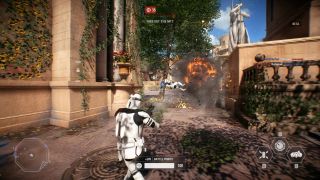
Loot boxes and progression
Playing matches and achieving simple milestones (eg, scoring your first five kills in any multiplayer mode) earns Credits, which can be used to buy loot boxes and Hero characters. You can also buy loot boxes with Crystals, the premium currency. Without spending any cash, I've been earning Credits and loot boxes at a good clip, and have started building a decent collection of Battlefront 2's primary customization element, Star Cards.
Each class, vehicle, and character can equip up to three Star Cards, starting with just one until you level the class up enough to unlock the other two. Star Cards can replace a stock ability with a new one—for instance, the Assault class can replace their grenade with an Acid Launcher—or buff an existing ability or stat, such as by decreasing all ability recharge times. I don't like the system. It's complicated, like Call of Duty's perks but craftable, purchasable, and upgradeable, and rewards high level players with seemingly significant advantages over new players.
Comic deals, prizes and latest news
Sign up to get the best content of the week, and great gaming deals, as picked by the editors.

Choosing between increasing the total health of my AT-RTs or reducing the damage they take or increasing the speed at which they auto-repair is comically dull.
I can't say exactly how much of a boost you get from Star Cards—as in, specifically how much faster ability recharge times are with the Resourceful card—but even if they're only slight boosts, they create the possibility to interpret deaths as power imbalances. Ah, we played rock, paper, scissors, but they had a Super Lava Rock that sets paper on fire. I should've known, but couldn't, because there's no way to tell what Star Cards are in play until you're dead.
And most of them aren't fun. New abilities are cool, but choosing between increasing the total health of my AT-RTs or reducing the damage they take or increasing the speed at which they auto-repair is comically dull. All three of those cards accomplish the same thing, and none will change how I play.
At least I haven't felt pressured to spend money. Most weapons are unlocked by scoring a certain number of kills, which is fine, and new Hero characters must be purchased with Credits—15,000 for Luke Skywalker, which feels like a bit much even after it was lowered from the absurd 60,000, but would also be a bit much if I were spending money on crates. When the multiplayer servers were briefly full of Origin Access players enjoying their 10-hour trial, I earned plenty of crates and Star Cards and Crafting Materials. Even playing the campaign earns you Credits.
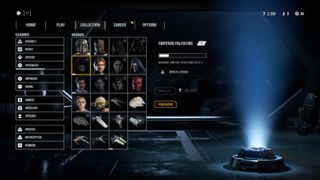
But even if I'm not buying it, the premium currency and the design of the entire progression system are interlocked. If you could equip three Star Cards per class right away, for instance, new players could fully outfit all their classes by spending money, without ever playing. Removing that restriction would probably be an unpopular move, yet having to grind for Star Card slots to equip straight hitpoint bonuses and damage upgrades isn't fun either. Without Crystals, the design could be tweaked. With them, it probably can't be.
Most of all, I'm disappointed by the unimaginative Star Cards contained in these loot boxes. The Call of Duty series has a lot of similar problems, including some stupid perks (namely, the ones that increase or reduce explosive damage), but at least they're usually trade-offs that enhance a specific style of play. Do you want to sprint faster or take no fall damage? That's a decision. But picking increased health, and increased primary weapon damage, and increased torpedo damage—that's just a better TIE Fighter. I'm not sure I'll feel great taking out first level players with my upgraded troopers and ships, whether I spend money or not.
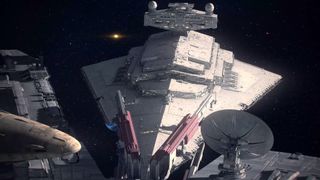
The campaign
It feels like a comic book that was drawn before it was written.
Battlefront 2's campaign features snappy levels that run through all the best Star Wars moments—piloting TIE fighters, exchanging blaster fire down too-white corridors, force pushing Stormtroopers. The story is disappointingly bland at times, but concise and entertaining. So far, the campaign is my favorite thing about Battlefront 2.
You primarily play as Imperial hero Iden Versio, leader of special forces team Inferno Squad, a ruthless villain who has very malleable morals—so malleable that she's largely unbelievable. There's one particular smash cut meant to show that Versio made a moral choice that I thought was a bug at first, because of how little convincing she required. It feels like a comic book that was drawn before it was written. Every other page features an exquisitely-inked battle we need to get to, so in between a few speech bubbles are filled in to explain why our characters are involved in it.
It's a classic Star Wars story of heroes and villains and good and evil, without surprise or subversion, which is disappointing. After a few missions, the characters all do exactly what they say they're going to do, and all agree with each other, and so much is glossed over that it's hard to understand why they act the way they do—we don't see most of their development, individually or as friends.
But going behind the scenes of big Star Wars battles is neat on its own, and there are funny lines, likable side characters, and cleverly-written cameos. Too few missions slow down to let us peek at a character's mind, but there is one that stands out. You play as a certain Force user and get to wipe out a squad of Stormtroopers with a lightsaber, which is both fantastically fun and a keen little look at how Empire lifers view the power of the Rebels, and vice versa.
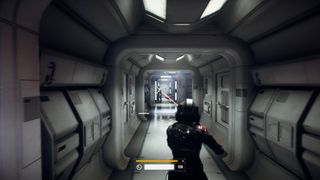
The hitboxes on enemy heads aren't as forgiving as they are in Destiny 2, but pretty close.
Using the Force with a lightsaber is appropriately easy, and I dug how it made me worry more about defeating an army with style than dying. As a hero of the galaxy, it wouldn't make sense for a Stormtrooper to even scratch me, and there's a fun game to trying to make my playthrough canon, mixing up cool abilities the way I think the character would. Holding down the right mouse button to auto-parry the same blaster fire I'd been hiding from in the previous mission feels badass.
Even in missions without space magic, though, Battlefront 2 isn't too hard. The hitboxes on enemy heads aren't as forgiving as they are in Destiny 2, but pretty close. And while I'm fragile enough to be on edge, I appreciate that Battlefront 2 lets me experiment, make mistakes, and recover. I feel in control and responsible for my success without having to resort to extremely cautious and tedious play—something cover shooters can encourage on higher difficulties.
The ships are hard to maneuver, for instance, but get close enough, and my main weapon soft-locks on an enemy—so I need to develop dogfighting skills, but I'm not expected to do it without a targeting computer. On the ground, I'm neither pinned to cover nor allowed to run around wherever I want. Only a few enemy types are spongy, and the rest often go flying through the air with a single grenade or headshot, which makes for proper-looking Star Wars battles. Fun, simple shootouts.
And the battles are gorgeous. DICE has outdone itself with the foliage on Endor.

The final mission is great fun, a mix of flying and ground battles with seamless transitions between massive props.
Turning the difficulty down didn't make a huge difference, so I worry players who are just in it for the story may find more challenge than they expected. A careful approach should get the job done where dancing around in the open isn't working, the only issue being that the checkpointed saves can be annoying, especially in space. Slightly too slow at destroying all the bombers because you went off to explore before the prompt showed up? Do the entire segment over. Did a great job with the bombers but accidentally clipped some debris? Start over.
I have encountered a couple bugs, as well. The most egregious was when I defended my grounded ship from endless waves of enemies for several minutes—I wasn't counting—before realizing something must be wrong. I reloaded the checkpoint, and sure enough, a boarding ramp was supposed to drop a couple minutes in so I could escape. At least it happened on the second try.
The final mission is great fun, a mix of flying and ground battles with seamless transitions between massive props, including AT-ATs and Star Destroyers. It also adds context to the events of The Force Awakens, and there's a cheesy enjoyment to learning about even more events the current cast of Star Wars heroes might not know about.
Later this week, we'll have a final, scored review. With the campaign finished, I'll be playing multiplayer and keeping track of how quickly I progress. Maybe Galactic Assault just needs to grow on me a little more—I haven't seen all the maps yet—or maybe one of the other modes is the real star. Multiplayer games can take a certain amount of practice before they click, so I'll keep blasting droids for a good while before I write down my final thoughts.

Tyler grew up in Silicon Valley during the '80s and '90s, playing games like Zork and Arkanoid on early PCs. He was later captivated by Myst, SimCity, Civilization, Command & Conquer, all the shooters they call "boomer shooters" now, and PS1 classic Bushido Blade (that's right: he had Bleem!). Tyler joined PC Gamer in 2011, and today he's focused on the site's news coverage. His hobbies include amateur boxing and adding to his 1,200-plus hours in Rocket League.
Most Popular




